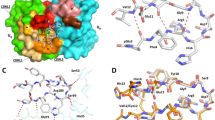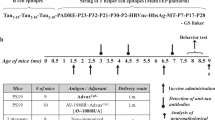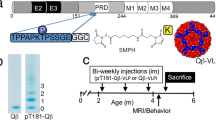Abstract
To characterize antibodies produced in humans in response to Aβ42 vaccination, we carried out immunohistochemical examinations of the brains of both transgenic mice and human patients with β-amyloid pathology. We collected sera from patients with Alzheimer disease who received a primary injection of pre-aggregated Aβ42 followed by one booster injection in a placebo-controlled study. Antibodies in immune sera recognized β-amyloid plaques, diffuse Aβ deposits and vascular β-amyloid in brain blood vessels. The antibodies did not cross-react with native full-length β-amyloid precursor protein or its physiological derivatives, including soluble Aβ42. These findings indicate that vaccination of AD patients with Aβ42 induces antibodies that have a high degree of selectivity for the pathogenic target structures. Whether vaccination to produce antibodies against β-amyloid will halt the cognitive decline in AD will depend upon clinical assessments over time.
This is a preview of subscription content, access via your institution
Access options
Subscribe to this journal
Receive 12 print issues and online access
$209.00 per year
only $17.42 per issue
Buy this article
- Purchase on Springer Link
- Instant access to full article PDF
Prices may be subject to local taxes which are calculated during checkout




Similar content being viewed by others
References
Selkoe, D.J. Alzheimer's disease: Genes, proteins, and therapy. Physiol. Rev. 81, 741–766 (2001).
Schenk, D., Games, D. & Seubert, P. Potential treatment opportunities for Alzheimer's disease through inhibition of secretases and Aβ immunization. J. Mol. Neurosci. 17, 259–267 (2001).
Walsh, D.M. et al. Naturally secreted oligomers of amyloid β protein potently inhibit hippocampal long-term potentiation in vivo. Nature 416, 535–539 (2002).
Chen, G.Q. et al. A learning deficit related to age and β-amyloid plaques in a mouse model of Alzheimer's disease. Nature 408, 975–979 (2000).
Geula, C. et al. Aging renders the brain vulnerable to amyloid β-protein neurotoxicity. Nature Med. 4, 827–831 (1998).
Götz, J., Chen, F., van Dorpe, J. & Nitsch, R.M. Formation of neurofibrillary tangles in P301L tau transgenic mice induced by Aβ42 fibrils. Science 293, 1491–1495 (2001).
Schenk, D. et al. Immunization with amyloid-β attenuates Alzheimer-disease-like pathology in the PDAPP mouse. Nature 400, 173–177 (1999).
Bard, F. et al. Peripherally administered antibodies against amyloid β-peptide enter the central nervous system and reduce pathology in a mouse model of Alzheimer disease. Nature Med. 6, 916–919 (2000).
Sigurdsson, E.M., Scholtzova, H., Mehta, P.D., Frangione, B. & Wisniewski, T. Immunization with a nontoxic/nonfibrillar amyloid-β homologous peptide reduces Alzheimer's disease-associated pathology in transgenic mice. Am. J. Pathol. 159, 439–447 (2001).
Morgan, D. et al. Aβ peptide vaccination prevents memory loss in an animal model of Alzheimer's disease. Nature 408, 982–985 (2000).
Janus, C. et al. Aβ peptide immunization reduces behavioural impairment and plaques in a model of Alzheimer's disease. Nature 408, 979–982 (2000).
Younkin, S.G. Amyloid β vaccination: Reduced plaques and improved cognition. Nature Med. 7, 18–19 (2001).
DeMattos, R.B. et al. Peripheral anti-Aβ antibody alters CNS and plasma Aβ clearance and decreases brain Aβ burden in a mouse model of Alzheimer's disease. Proc. Natl. Acad. Sci. USA 98, 8850–8855 (2001).
DeMattos, R.B., Bales, K.R., Cummins, D.J., Paul, S.M. & Holtzman, D.M. Brain to plasma amyloid-β efflux: A measure of brain amyloid burden in a mouse model of Alzheimer's disease. Science 295, 2264–2267 (2002).
Solomon, B., Koppel, R., Frankel, D. & Hanan-Aharon, E. Disaggregation of Alzheimer β-amyloid by site-directed mAb. Proc. Natl. Acad. Sci. USA 94, 4109–4112 (1997).
Backskai, B.J. et al. Imaging of amyloid-β deposits in brains of living mice permits direct observation of clearance of plaques with immunotherapy. Nature Med. 7, 369–372 (2001).
Bishop, G.M., Robinson, S.R., Smith, M.A., Perry, G. & Atwood, C.S. Call for Elan to publish Alzheimer's trial details. Nature 416, 677 (2002).
Hsiao, K. et al. Correlative memory deficits, Aβ elevation, and amyloid plaques in transgenic mice. Science 274, 99–102 (1996).
Duff, K. et al. Increased amyloid-β42(43) in brains of mice expressing mutant presenilin 1. Nature 383, 710–713 (1996).
Holcomb, L. et al. Accelerated Alzheimer-type phenotype in transgenic mice carrying both mutant amyloid precursor protein and presenilin 1 transgenes. Nature Med. 4, 97–100 (1998).
van Dorpe, J. et al. Prominent cerebral amyloid angiopathy in transgenic mice overexpressing the London mutant of human APP in neurons. Am. J. Pathol. 157, 1283–1298 (2000).
Calhoun, M.E. et al. Neuronal overexpression of mutant amyloid precursor protein results in prominent deposition of cerebrovascular amyloid. Proc. Natl. Acad. Sci. USA 96, 14088–14093 (1999).
Hsiao, K.K. et al. Age-related CNS disorder and early death in transgenic FVB/N mice overexpressing Alzheimer amyloid precursor proteins. Neuron 15, 1203–1218 (1995).
Iglesias, A., Bauer, J., Litzenburger, T., Schubart, A. & Linington, C. T- and B-cell responses to myelin oligodendrocyte glycoprotein in experimental autoimmune encephalomyelitis and multiple sclerosis. Glia 36, 220–234 (2001).
Poduslo, J.F. & Curran, G.L. Amyloid β peptide as a vaccine for Alzheimer's disease involves receptor-mediated transport at the blood–brain barrier. Neuroreport 12, 3197–3200 (2001).
Hyman, B.T. et al. Autoantibodies to amyloid-β and Alzheimer's disease. Ann. Neurol. 49, 808–810 (2001).
Monsonego, A., Maron, R., Zota, V., Selkoe, D.J. & Weiner, H.L. Immune hyporesponsiveness to amyloid β-peptide in amyloid precursor protein transgenic mice: Implications for the pathogenesis and treatment of Alzheimer's disease. Proc. Natl. Acad. Sci. USA 98, 10273–10278 (2001).
Check, E. Nerve inflammation halts trial for Alzheimer's drug. Nature 415, 462 (2002).
McKhann, G. et al. Clinical diagnosis of Alzheimer's disease: Report of the NINCDS-ADRDA Work Group under the auspices of Department of Health and Human Services Task Force on Alzheimer's Disease. Neurology 34, 939–944 (1984).
Folstein, M.F., Folstein, S.E. & McHugh, P.R. “Mini-mental state”. A practical method for grading the cognitive state of patients for the clinician. J. Psychiatr. Res. 12, 189–198 (1975).
Acknowledgements
We thank D. Schenk, R. Black and A. Aguzzi for critical reading of the manuscript; A. Fontana for helpful comments; E. Garcia, C. Wilde, A. Walther, and R. Schmid for clinical study support; J. Tracy and J. Bosset for technical support; M. Jaber for artwork; the Netherlands Brain Research Institute, A. Deng, M. Frosch and A. Aguzzi for brain tissue samples; K. Duff and K. Hsiao-Ashe for transgenic mouse lines; and Evotec NeuroSciences GmbH for antibodies. This study was funded in parts by the National Center of Competence in Research on Neural Plasticity and Repair, the EU DIADEM programme on Diagnosis of Dementia, the Stammbach Foundation and the University of Zurich.
Author information
Authors and Affiliations
Corresponding author
Ethics declarations
Competing interests
The authors declare no competing financial interests.
Rights and permissions
About this article
Cite this article
Hock, C., Konietzko, U., Papassotiropoulos, A. et al. Generation of antibodies specific for β-amyloid by vaccination of patients with Alzheimer disease. Nat Med 8, 1270–1275 (2002). https://doi.org/10.1038/nm783
Received:
Accepted:
Published:
Issue Date:
DOI: https://doi.org/10.1038/nm783
This article is cited by
-
Genistein effect on cognition in prodromal Alzheimer’s disease patients. The GENIAL clinical trial
Alzheimer's Research & Therapy (2022)
-
Transformable peptide nanoparticles arrest HER2 signalling and cause cancer cell death in vivo
Nature Nanotechnology (2020)
-
Bee venom phospholipase A2 ameliorates Alzheimer’s disease pathology in Aβ vaccination treatment without inducing neuro-inflammation in a 3xTg-AD mouse model
Scientific Reports (2018)
-
A Novel scFv Anti-Aβ Antibody Reduces Pathological Impairments in APP/PS1 Transgenic Mice via Modulation of Inflammatory Cytokines and Aβ-related Enzymes
Journal of Molecular Neuroscience (2018)
-
T cell responses in the central nervous system
Nature Reviews Immunology (2017)



